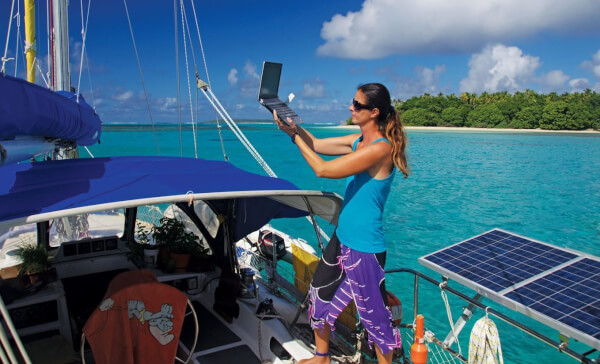Communication Options at Sea…
Nowadays a broadband connection at home is standard for almost everyone in the Western world. Smartphones enable people to be online wherever they are all day long to inform Facebook friends about everything they are doing, Google for information, or upload and download huge files in a jiffy. By comparison, Cruisers live in the Dark Ages of Communication.
- Almost every yacht has a VHF radio for emergencies (“Big Ship, we’re on a collision course!”); to communicate with officials, listen to weather reports and warnings, and chat with fellow cruisers, however, the range of VHF signals is limited to a few miles.
- Near shore mobile networks are available for phone calls or to access the Internet with a 3G modem, and it’s advisable to get a local SIM card when staying in one country for any length of time. Away from cities, 3G quickly turns into 2G and with this meager data rate surfing the web feels more like floating… desperate cruisers position their laptops on the Bimini and we’ve even spotted cruisers in dinghies with their laptop held up high in search of the elusive www. A bad connection is especially annoying in combination with a costly price.
- Often Wi-Fi hotspots in towns and marinas can be used from the anchorage. An amplification antenna helps with weak or distant signals. Especially convenient are models that combine antennas for Wi-Fi and mobile phone networks, for example, The Wirie pro. www.thewirie.com

Single-sideband (SSB) radios are a traditional means of communication for cruisers.
We use an inexpensive Yaesu FT-857 that yields excellent quality in combination with a CG3000 automatic antenna tuner and a wire cable up to the masthead as an antenna (much cheaper than the prettier solution of an isolated backstay). Via SSB cruisers can participate in SSB/HAM nets to share info about weather and sea state with other yachts on passage or listen in on local nets for insider info on anchorages or infrastructure (see cruising guides for times and frequencies).

In combination with a pactor modem (unfortunately almost as expensive as the radio itself), SSB facilitates worldwide email service.
Winlink is a network of HAM stations (license required), the account and use is free. Incredible but true, HAM clubs and navy base clubs have set up giant stations, often including directional antennas and stacks of radios and pactor modems to enable simultaneous connections on different frequencies. Users receive long lists with stations around the globe and their frequencies. This fabulous service provides cruisers on passage or in remote anchorages with a link to the outside world. You call a station via pactor modem, the station is connected to the Internet and sends on your emails (text only).

Saildocs provides a great service: Via email you request certain weather forecasts or any website (text only).
We receive weather forecasts as text bulletins and grib files (A 10-20 kbyte file takes several minutes to download). It’s even possible to access ordinary email accounts such as Yahoo and Gmail; read RSS news feeds and post blog entries including position reports during passages. Cruisers without a HAM license can use the SailMail network that also provides worldwide pactor stations. It uses marine radio frequencies, the account costs US$275 per year.
Installation, set-up and use of SSB (and therefore Winlink and SailMail) requires a certain amount of technical know-how and due to the nature of wave propagation, SSB connections only work during short time windows depending on solar activity, time and season.
Cruisers who can’t be bothered with such restrictions can stay in touch with the world via satellite phones. Different providers offer services for different demands. Iridium has worldwide coverage, but the equipment is quite pricy (US$700-1000) and there are additional costs for prepaid cards (about US$700 USD for 500 minutes, valid one year). For cruisers in the Caribbean, Globalstar (covers only coastal waters) is a less costly alternative. Satellite phones function as modems when connected to a laptop with a USB cable. Iridium GO! creates a local Wi-Fi hotspot that can be used with a smartphone. Unfortunately the data rates are also limited to max. 18 kbytes/minute. Inmarsat offers global broadband, but due to the elaborate equipment (special antennas) and high prices its target groups are rather commercial ships and superyachts.

We know cruisers who successfully make long passages without any communication equipment at all, free and spontaneous like in the olden days. We pick safety over romantic notions, get daily weather forecasts and stay in touch with family and friends at home. We happily spend 20 minutes every day listening to the cryptic singing and howling of the ether and send our current reports from the South Seas to all out there who are interested at: www.pitufa.at





